Sep 29, 2009

It would probably be overkill to have a low-trail fork and an extended rear triangle so i could put both a porteur rack and xtracycle-style panniers on the thing. But, hey, if I won the lottery I’d have money to burn and what better to burn it on?
—orc Tue Sep 29 11:09:50 2009
Sep 28, 2009
It claims that the Barlow 300k (or at least the subset that I rode before I froze to death) has 18,000 feet of climbing. If true, that would be impressive, except that I stopped a couple of times during the day and watched the GPS claim with a straight face that I was first going up 50 meters, then down 80 meters, all over the course of about 2 minutes.
14,000 feet sounds believable, maybe, but the Garmin 205 doesn’t seem to have a very good “enhanced 3d” mode on it. (It also tends to drop readings when it’s obstructed, but that, fortunately, doesn’t appear to do more than a 1-2% underreading of the distance I’ve travelled.)
—orc Mon Sep 28 22:43:48 2009
Sep 27, 2009

Well, I did a 300km loop. But it wasn’t the loop I signed up for.
I don’t ride many (any is more like it) brevets, because I live in Portland, don’t have a car (or even a driver’s license), and 99.9% of the local routes start in far suburbia, which involve long bike rides early in the morning before I even get to the actual ride.
The Barlow 300 is one of those loops, but I managed to talk myself into riding it because (a) I’d previously ridden one of Michael Wolfe’s permanents and found it to be quite enjoyable, and (b) I ride out to Sandy 3-4 times a month either for donuts or as part of a more extensive ramble in Clackamas County, so I was fairly confident I could make it out there at a leisurely pace and still have enough energy left for the loop.
So on Friday night I loaded up the bicycle with everything I needed, set out some clothes, set the alarm for 3:15am, and went to sleep. 6 short hours later, the alarm pulled me out of my sleep, I gobbled a quick breakfast, tossed on my clothes, and headed on in the DARK and COLD for Sandy, via a combination of streets (Woodstock & Foster), the Springwater Trail (111th out to Rugg Road) and highways (Telford Road/OR212/US26), arriving there a slothful 110 minutes later (because (a) I wanted a leisurely pace, and (b) I’d ridden out to Sandy on Friday and I didn’t seem to have much energy then, so I was being very paranoid on the leisurely front.)
20 short minutes later the starting flag waved (“It’s 6am; have fun!” or words to that effect) and the dozen or so riders headed south towards the Clackamas River. Now, my xtracycle is a fine vehicle that’s quite comfortable for me to ride, and it can run surprisingly fast on level ground and downhills, but it’s laughably slow on any sort of hill, so as soon as we hit the first uphill (climbing out of the Tickle Creek watershed) it was as if I was the Coyote and the rest of the mob was the Road Runner; everyone vanished into the distance as if they had been shot out of a cannon, and aside from overhauling some of the Seattle contingent (who did the Road Runner thing when the first uphill was encountered at the north end of Faraday) when they stopped to fix a flat on Faraday that was the last I saw of any of them. Later on, I was passed by a couple from Washington (Brian & Kyly) who were only slightly faster than I was, so we played leapfrog for the next 100 or so miles until they dropped me for good at the top end of Barlow Pass, but for the vast majority of this loop it was just me poking along like Pete the alligator.

Going over the mountain for the first time went pretty much as I expected; I was able to make good speed on OR224 as it followed the Clackamas River south (despite a fairly substantial headwind,) I made okay progress on OR224 when it bent east and headed up and away from the Clackamas River, and, after a short stop at Ripplebrook where I searched for a promised water hose but could not find it for love or money , I made the expected tortoise-like creep up NFD57, 58, and 5810 to the first control just before the Anvil Creek washout, arriving there 30-odd minutes before it closed. This didn’t bother me, because this was pretty much the top of the mountain and I knew that I’d make up a whole bunch of time getting to the next control (at Maupin, 50 miles east and, more importantly, 3800 feet down from Anvil Creek.)
It was a little bit slower than I expected getting over the next 10 miles of mountain, because of the Anvil creek washout (800 feet of washed out road, which included shoving the xtracycle up a steep fill bank after I crossed the [dry] riverbed,) stopping to take pictures at Timothy Lake, and a couple of stops to shed layers in preparation for the descent. But, after spending a hour or so poking across the top of the mountain, I hit 26 again and started a precipitous descent into the high desert of central Oregon. 26 gave me an appetizer by a nice 400 foot drop (and then took it away by a 250 foot climb), and then I turned onto highway 216 and things started getting interesting.
A mile or so into 216, I stopped for a minute to strip off the last layer of long-sleeved clothes, and while I was doing it I heard Brian & Kyly chatting in the near distance. I clambered back into the Trek and started rowing off to the east, fully expecting that I’d be passed quickly, when the road tilted downwards and a tailwind started up.
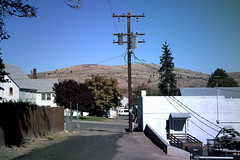
I wasn’t passed. For once, they were the Coyote and I was the Road Runner. The combination of xtracycle, steep downhill grades, and a strong tailwind meant that I reeled off the rest of the descent into Maupin at an average speed of around 30mph, and even including the time I spent looping through downtown to find a market I had over 2h30 left on the clock when I got my brevet card signed.

I was fairly sluggish at this stop, and Brian & Kyly caught up to me while I was poking around in the market, so we continued as a group to the next control (10 miles up the river after an against-the-headwind ride up a rail-path,) where I took full advantage of the Deschutes River to bathe my feet before starting to climb back up the damned mountain again.
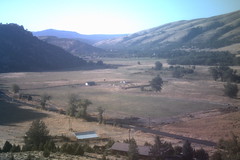
And then we turned around and went up the damned mountain again. This started poorly – the road from the Deschutes up to Wamic starts nicely, but when it finished climbing out of the gorge I wasn’t able to push up to a better cruising speed because there was a wicked crosswind that kept blowing the back end of my bicycle across the road, and after fighting that I didn’t have much energy to actually accelerate – but got better when the road went up the ramp from Tigh Valley to Wamic, because there the wind was blowing me up the hill.
I was delayed on the way into Wamic by a fellow in a SUV who waved me down and grilled me about what I was doing and where I was planning on going, and who was dumfounded and amazed when I told him I’d started in Portland and was trying to go back that same day. I chatted with him for 5-10 minutes before I was able to extricate myself and proceed into Wamic, where I encountered Brian & Kyly again, and discovered that I had about 1h30 extra time available for the climb up to Barlow Pass.
So far so good, if not for that pesky sun. We proceeded up towards the mountain, over cattle bars and expansion cracks, and reached the first long ramp up into the mountain just as the sun vanished below the treeline. This is where it started to get unpleasant – the thing about riding in the dark is that you end up riding in a little cave of light with no visual clues about where you are. I was leapfrogging Brian & Kyly, and
I didn’t even think that it might be a good idea to ask them if I could ride as a group. As it was, I’d pass them, ride along with them, we’d hit an upgrade, and they’d vanish into the distance as I continued along. This went on until we were around 9 miles from the top of Barlow Pass, where we hit an upgrade and they vanished ahead, never to be seen again.
So there I was on the Barlow trail in the middle of the night (~9pm) winding my way upwards with no external reference except the occasional glimpse of Mount Hood looming ghostily over me. This is where I started to think I might not be able to finish the loop, because I was now creeping along very very slowly. I got a cramp in my right knee, so I had to hop off the bicycle and push it for a while, and later I wanted to drink one of the coffee drinks I’d brought along so I walked while I did this, and at ~9:45, when I was three miles from the top of the pass, I got back into T-Mobile cell range, at which point the phone lit up with frantic messages from home (and then immediately died from battery exhaustion, so I had to pull out the other cell phone, move the sim card over into it, and use that to phone home and tell the best that I wasn’t dead but was instead sitting out on the Barlow Trail in the middle of the night.)
But, even with all of that, I reached and turned onto 35 at just a little after 10pm, and figured that I could make the next 7 miles into Government Camp without too much trouble.
But then I hit a downhill and was reminded that it was really effing cold up here at 4000ASL. In the course of about 600 feet I made three stops to shovel additional layers on, and finally got to the point where I thought I was warm enough because I wasn’t shivering.
I wasn’t warm enough; I was so cold that my body had given up shivering and it was busily trying to find ways to conserve core heat. And when I was 2 miles out of Government Camp, I started to get nauseous, so I first got off the bike and tried to walk it, then tried to ride it, and then, just as I reached the top of the climb (the ½ mile to Timberline Lodge sign) I had to sit down on the ground (which didn’t actually feel cold) and DNF the loop because there was no way on G-ds green earth that I’d be able to make that last couple of miles down to the Mount Hood Inn to get my brevet card signed in the next 20 minutes.
Michael Wolfe said that this control wouldn’t matter if I could make it in, and the best, when I called her with my status plans (for some reason she didn’t think that sitting out on the side of the highway with the bicycle was likely to be a good plan) both suggested that I find a place to warm up before continuing on down this hill. So I did. And I sat there just looking at a platter of food I’d ordered for 45 freaking minutes until my body warmed up to the point where it decided that shivering might be a good idea.
I suppose I could have tried to blow down the hill and get to Sandy. It’s only about 27(29?) miles from Government camp, and 95% of that is steeply downhill. But I was still really cold, and flirting with hypothermia wasn’t very fun the first time I tried it that night. So I left the towel thrown in, and ended up being rescued by a fellow randonneur, who drove up from Sandy, grabbed me and the bike, and returned me to the end of the line (I tried to get a room in Government Camp, but there was apparently an ultrarunner loop going on on Saturday, and as far as I could tell every hotel room up there was occupied by a runner who’d just come back from a pleasant 108 mile run around the mountains.)
And then I woke up early this morning, hopped on the bicycle, and came back home.
I think that I’ve got the idea of how to pack for a long trip now. Of all the things I loaded up on the Trek, the only thing I didn’t use was a spare pair of underwear, and that was very useful this morning. There are only a couple of things I didn’t pack that I should have – I forgot to bring along a few of those little iron-based heat packs, I need to carry a survival blanket when I’m on a loop that takes me out into the dog end of nowhere, and those downhill ramps in the dark? Layer up before heading on down, because it takes approximately 10 seconds for the wind to rip all of the heat out of my body. (Actually, if I layered up before the ramp I wouldn’t need #1 or #2, but survival blankets & head packs are very light for the paranoia value they provide.)
It turns out that the only thing that didn’t work (aside from me) was my pedals. I bought a pair of Trek-branded rattraps with toeclips at the LBS (the MKS Sylvans are better, but they’ve got a little spike on the outside edge which pushes my feet into the crankarms. Plan B will, I believe, start with a an angle grinder,) but the geometry of the toeclips is pathetic. every time I unclipped my right foot it took me repeated stabs at it to get the pedal upright and my foot into it before I could re-clip in, because it would either whip around too fast or the clip would fold over and not let my feet into it. I probably spent two hours yesterday pedalling on the bottom of that pedal because it was too damned dark to properly spot while clipping in.
I’d love to ride this brevet again, but I don’t think I can do it on the Xtracycle. It’s not really that pleasant to ride at night, and if I ride the Barlow Trail on the Xtra I have to allocate at least 12 hours for climbing, which, even on the longest day of the year only leaves me 4 hours for everything else. So I’ve got to build the midlife crisis mobile so I can have something shorter and lighter to push up the mountain. And if I ride it again, I’m going to go up to Sandy on the day before the loop so I don’t have to wake up at ohdark15 to make it out there.
And I’d have to get my family to agree to it, which probably means I’d need to rent a satellite phone so I don’t drop off the face of the earth during the loop (which means that I’m going to be stuck doing the 2-3 200k permanents that loop out of Portland for the forseeable future :-( )
(And if you’re wondering how I got 300km after I bailed at Government Camp, consider: When you include the ride up to Sandy and a wrong turn I took shortly after Anvil Creek, it comes to close to exactly 300km. And the GPS, which I turned off when I abandoned just this side of Government camp, claims 296 km before I went the two miles into Government Camp, then wandered up and down Government Camp loop trying to find the official controls before giving up and seeking refuge in the Huckleberry Inn. I’m not proud. Tired, maybe, but not proud.)
—orc Sun Sep 27 23:58:25 2009
Sep 25, 2009
A couple of weeks ago – almost immediately after I tore down the bicycle and repacked all of the bearing surfaces that were creaking (not a very long list – the brand new bottom bracket had picked up a bunch of dirt when I went for a long ride in the rain which had worked its way into the outermost threads of the BB shell, and the two dropout bolts on the free radical had worked their way loose enough so they were fretting against the dropouts) – my saddle started to squeak at almost any provocation. I applied some lubricating oil, which seemed to quiet it, but in a couple of days it was back to squeaking, and then I applied some grease to the rails, which did the same.
That’s funny, thought I, perhaps I didn’t lay in the grease liberally enough. So I unscrewed the saddle, shovelled a lot of grease into the saddle clamp, and attempted to bolt the saddle back on. It screwed down to hand-tight, but then the bolt just started spinning freely without showing any signs of tightening.
“Golly,” I said, as I tightened frantically, “the seatpost is ruined! I’ll have to replace it”
I unbolted the saddle clamp and took a look at the bolt. About halfway down the bolt there was a little spiral of metal trapped in the threads. A little spiral of metal that had, 20 or so years ago, been the thread cut into the special nut that clamped the whole assembly together, but which had slowly sheared loose under the repeated impacts of a 180-190 pound rider on the somewhat less than optimal surface of the Springwater Trail and the chipseal roads I ride on out in the country. When I looked closely at the spiral, the sheared surface was almost all burnished by rubbing against the nut except for a tiny amount at one end, which was just waiting for an opportunity to say “Ha ha!” when I was out in the countryside.
Well, that seatpost was trash. I’d just have to take it out and verify the seatpost diameter, then go to the hardware store, buy some emergency bolts, and bolt the whole thing together for the trip over to the LBS for a replacement. So I’ll just unbolt the seatpost and, um, oh oh.
The binder bolt on my poor bicycle has suffered through a lot, including a lot of saddle adjustments years ago when I didn’t have a metric hex driver. So the cap was rounded, and every time I’d been adjusting it this year I managed to chip away at the remaining corners, until this particular day, when I twisted the hex driver and it, too, just spun helplessly.
*siiiiiiiiiigh*
At least I have a hacksaw, and there’s enough room between the seat tube and the rear brake bridge to fit that hacksaw in so I could SAW THE BOLT IN HALF. And then I went to the hardware store and got two new bolts, plus enough nuts and washers to clamp the seatpost together so I could saddle up and ride over to the LBS and buy a new no-name seatpost (which, despite being longer than the old Kalloy seatpost that came with my Trek, weighed 40 grams less) in almost deathly silence (broken only by the occasional ghostly groan from the seat rails on my Brook saddle.)
As a general rule, I don’t like to replace components two days before I go on a really long bike ride (like the 300 km one I’ve talked myself into for 3:45am tomorrow morning), but having a saddle that isn’t attached by a rube goldberg kludge seems like a good reason to break this rule. At least if the new seatpost messily disassembles itself 10 miles out of Maupin I’ll be able to go back into the LBS and make nasty comments about components that disassemble themselves within 300 miles of purchase.
—orc Fri Sep 25 22:17:34 2009

Still life with Dust Mite, green hanky, pink legos, and random computer bits.
—orc Fri Sep 25 20:55:39 2009
Sep 23, 2009
Dearly Beloved,How are you? hope you are keeping healthy,
i am very sick and dying of cancer and
I AM SICK AND DYING OF CANCER
i am very sick and dying of cancer and
I AM SICK AND DYING OF CANCER
I have been diagnosed with cancer. It has defiled all forms of
diagnosed with Esophageal cancer . It has defiled all forms of medical
diagnosed of Cancer of the Pelvic.
diagnosed of Cancer
esophageal cancer of the lungs which also affected my brain,
cancer stage has gotten to A very bad stage.
cancer of the lungs. I have since lost my ability to talk
cancer of the lungs which also affected my brain
cancer stage has gotten to a very
treatment for cancer of the lungs.
cancer of the lungs which also affected my brain
cancer stage has gotten to a very bad
treatment for cancer of the lungs
time cancer of the brain .From all indication my condition is really
cancer stage has
time cancer of the brain .From all indication my condition is really
cancer stage has
time cancer of the brain .From all indication my condition is really
cancer stage has
cancer problem (cancer of the lever and stroke).
remember me in your daily prayers because of my up coming Cancer Surgery.
cancer problem (cancer of the lever and stroke).
remember me in your daily prayers because of my up coming Cancer Surgery.
I am suffering from a long time cancer of the brain
because the cancer stage has reached a critical stage
death i fell sick and the doctor diagnosed that i have cancer of the lungs
sick and the doctor diagnosed that i have cancer of the lungs
cancer of the breast and Pneumonia.
due to cancerous illness
what bothers me most is the stroke that I have in addition to the cancer
months due to cancer problem.
The one that disturbs me most is my stroke sickness.
the next eight months due to cancer problem.
The one that disturbs me most is my stroke sickness.
sickness which is cancer problem and one that disturbs me most is my stroke
sickness which is cancer problem
I AM PRESENTLY IN HOSPITAL SUFFERING FROM CANCER
AND I HAD A STROKE WHICH HAS AFFECTED MY
CANCER RESEARCH FACILITY
I AM NOW OLD AND SICK WITHOUT A HUSBAND AND CHILDREN. THIS HAS MADE ME UNHAPPY.
9 MONTHS NOW I HAVE BEEN SERIOUSLY SICK.
I AM PRESENTLY IN HOSPITAL SUFFERING FROM CANCER
AND I HAD A STROKE WHICH HAS AFFECTED MY
NEW CANCER RESEARCH FACILITY
SUFFERING FROM LONG TIME CANCER OF THE BREAST,
FROM ALL INDICATION MY CONDITIONS IS REALLY DETERIORATING
THE CANCER STAGE HAS GOTTEN TO A VERY BAD STAGE.
cancer of the breast.
cancer problem.
diagnosed with Esophageal cancer .
my Doctor told me that i have serious sickness which is cancer
because the cancer stage has gotten to a very severe state
The one that disturbs me most is the stroke
I am diagnosed of Cancer of the Larynx and it is terminal,
I would not last for the next 15 days due to cancer problem.
Though what disturbs me most is my stroke.
suffering from cancerous ailment.
the cancerous problems I am suffering from.
the stroke that I have in addition to the cancer.
I was diagnosed of cancer for about 2 years now.
my cancer problem (cancer of the lever and stroke).
Cancer
due to cancer problem.
due to cancer problem.
Cancer of the Breast.
now i am seriously sick. I have been diagnosed with Cancer
the next Eight months due to cancer problem.
The one that disturbs me most is my stroke sickness.
I would not last for the next 15 days due to cancer problem. Though
what disturbs me most is my stroke. Having known my condition I decided
have been receiving dialysis in a hospital, after cancer damaged my kidneys
Eight months due to cancer problem damaged my kidneys
I am 58 years old and I was diagnosed for cancer
Eight months due to cancer problem.
The one that disturbs me most is my stroke sickness.
I would not last for the next Eight months due to cancer
for you and for your time.
(lyrics reaped from about a year’s worth of hand-picked spam.)
—orc Wed Sep 23 20:25:27 2009
Sep 22, 2009
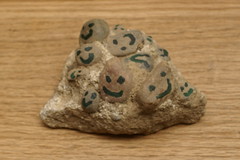
Silas has been sick for about a week now (possibly with genuine influenza), but is now starting to get over it. How do I know? Well, he wanted to go outside today, and when we let him out (it’s in the high 20s/80s) he immediately proceeded to our concrete rubble pile and made a piece of debris much happier.
—orc Tue Sep 22 15:01:22 2009
Sep 21, 2009
So.
I can go out and buy a porteur rack for my hypothetical mid life crisis mobile and a randonneuring-type rack for the heavy iron ball, but that would cost somewhere in the ballpark of US$200 ($100 for a CETMA 5-rail porteur rack and another $100 for some Nitto-ish small rack.)
Or I could go out and buy a brazing torch ($65 for “sized for home repair” one at the hardware store), a tube bender ($30, same place), and a small mass of steel tubing ($40?) and glue some up instead.
And that would give me a brazing torch I could use to repair the three cooling racks that have broken welds and are now tippy 3-legged racks with sharp rods sticking out of them.
And if I was able to glue up my own racks, I could drop on mounting points for lights, my GPS units, and the front bag I’ve partially sewn up and have left waiting for a rack so I can properly fit it with hold-down straps.
And and it would give me brazing practice so if I snapped and wanted to add tiedowns to metal objects (like, oh, bicycle frames and forks) I could do so by myself instead of hiring some framemaker to do the work at $50-1000/hour.
Decisions, decisions.
—orc Mon Sep 21 22:58:20 2009
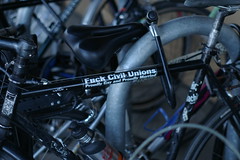
Spotted on a bicycle down at the Big Big Big Store; I enthusiastically endorse this statement in favor of real marriage equality (civil unions are just fine if you stay in the ghetto and never ever travel out of town, but civil rights must apply everywhere in this godforsaken banana republic.)
—orc Mon Sep 21 22:41:14 2009

I went up to the Seven Corners big big store today, and when I reached the railroad crossing on Division St I noticed that the signals were (a) on and (b) green. So I tarried a while, and was soon rewarded by the sight of this Yellow Menace freight creeping southwards on the ex-SP mainline.
I don’t know if it was still creeping on by after I finished my shopping trip, because I went home via Clinton/41st/Woodstock (complete with a short but intermittently enthusiastic hillclimb – 50 meters isn’t very much compared to 800 meters, but I’m not going to carry 50 pounds of groceries on a R300 either) which conveniently avoids all grade crossings and possible ambulatory obstacles on the way.
—orc Mon Sep 21 22:27:10 2009
About 8 years ago, I reluctantly abandoned the elm mail reader due to the increasing amount of mime-infested mail I was receiving. All of the other mail clients I looked at sucked compared to elm, but the mutt client sucked least. So I downloaded it (version 0.95.4i) onto Pell and started using it on most of my machines without too many spasms of software loathing.
Time passed, and some of my servers were taken out of service and replaced with others, some using the original software installs and some being newly installed. I did a new install of FreeBSD 4.8 on my home file/dhcp/gateway server a couple of years ago when I collapsed my home network down from a trio of 150+watt Athlon servers to a 20 watt VIA-based server (I tried to install FreeBSD 6.2 on the thing, but the IDE drivers on FreeBSD 6.2 dumped core whenever they tried to talk to the installer CDs. 4.8 was fairly picky about the CD, but it didn’t dump core when I installed the OS onto the box) and ended up without a point-and-drooly mail reader.
And, of course, I had to upgrade some of the software on downbelow. Sendmail was discarded in favor of Postoffice, I replaced the standard ls program with one I’d written myself as part of Mastodon, and a few other programs were also swapped out in favor of the better software that I’ve written. Unfortunately, some of the FreeBSD maintenance scripts use command line
switches I don’t support, so my mailbox on downbelow fills up with complaints about
the (not supported yet) -Ac switch for mailq, a missing switch that’s used to detect
setuid for ls, and, probably, a couple of others. And if I don’t check regularly, the mailbox fills up with junk and it’s a real pain to wade through it with the Berkeley mailx reader.
So this morning, I said to myself “why don’t I just install mutt and be done with it?” And, after asking, I went online and downloaded the most recent version of the software from the mutt website. It’s huge compared to the older version I’m using on pell, but I went ahead and copied it over to downbelow, unpacked it, and ran the thrice-damned gnu configure program it comes with.
gnu configure did it’s usual round of checking for about 100,000 things that don’t matter, whined (actually, gcc) whined about various gnuisms that aren’t supported in ANSI C, and finally spat out a bunch of makefiles. Okay, time to run make and, oh look, there are errors rolling forth like vomit from a cat.
Mutt 0.95.4i, on the other hand, compiled without complaint.
It might be difficult to set up an Alpha box to run Digital Unix these days, but it’s not even slightly difficult to install an old version of FreeBSD onto an old PC, or even in a virtual machine running on your bleeding edge Linux®©™ development machine (that is if you’re actually interested in writing portable software instead of trapping your userbase into some Open Source®©™ tarpit that requires that you run the latest version of some Linux®©™ distribution (or MacOS) to even have a fighting chance of building the effing software, let alone use it?) Why even bother to use the (stupid!) gnu configure program if you’re not even willing to make your code actually work?
—orc Mon Sep 21 12:03:37 2009
Sep 18, 2009
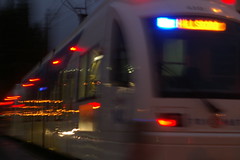
A pair of SD70s were paused at the Convention Center stop as we returned home from Russell Street BBQ last night.
—orc Fri Sep 18 22:31:50 2009
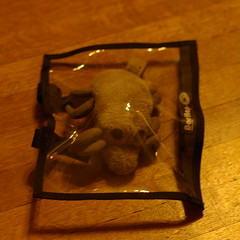
Do not believe the lies; a Dust Mite does not make a good cue sheet.
—orc Fri Sep 18 22:28:22 2009
Discount is now at version 1.5.5, which corrects a narsty little defect in the table code (I was expanding an array where I wanted to be truncating it, which gave me all sorts of exciting uninitialized data to use as array indices.
Which gave me core dumps. But only if I built discount with the proper set of build options, otherwise the malformed table would just become line noise! And the build options I use were not the proper set, so I never got caught.
*sigh* I’m going to strip all of the build options out soon and release a 2.0 version that has all the options runtime only, but for now this New Code! is all I’ve got to correct some of the excitement in the new table code. You should grab it unless you run markdown with -fnotables all the time.
—orc Fri Sep 18 18:07:24 2009
Sep 15, 2009

This sort of ride would probably be too much for me, but, then again, maybe it would not. It’s like climbing Larch Mountain twice, with another 100 miles of upping and downing thrown in for good measure (two Cascade range crossings on the way out to the Deschutes river and back.) It would take approximately forever×2 for me to climb up to the ridgeline (made even better by each climb being about 40 miles long – if my experience climbing Larch Mountain is any indication I’d end up being hoisted aloft by the bee parade before I reached the summit) but there would be some compensation for this by the gravity-assisted plunges down off the mountain in return.
But it starts in Sandy, which is 1h55 (and 40km) away from home. The idea of waking up at 3:30, riding two hours, then riding 18-20 hours (if I look at on-the-move-time on some of my shorter loops, it would “only” be 15 hours, but something always comes up to slow me down,) then riding another two hours or so to get back to my cozy bed at home (normally it takes me about 1h20 to to get back from Joe’s Donuts , but in the dark? Along highways 26 and 212, then Foster/Woodstock? No, speed would not be of the essence here. Not dying would be of the essence) is a fairly daunting concept.
But, oh the thought of dragging the mighty xtracycle over the mountains twice in one day. I could do it once, and then I’d have to do it again to get home. It’s very tempting. Too bad it starts in Sandy.
—orc Tue Sep 15 20:39:10 2009
Sep 13, 2009
Sep 12, 2009
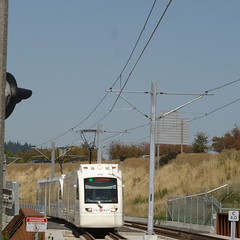 <-
->
<-
->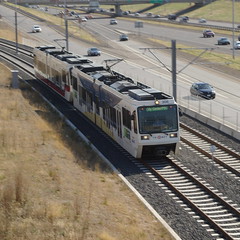 <-
->
<-
->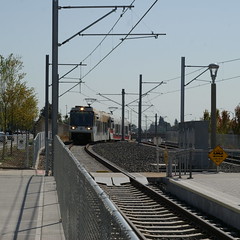 <-
->
<-
->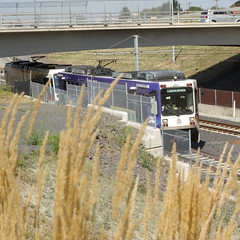
Tri-Met’s latest trolley line – the green line to Clackamas Towne Center – opened for revenue service today, and I took a leisurely ride up and down the Woody Guthrie path taking pictures of all of the different types of trolley cars that are now running in revenue service on the line.
Note that the Bombardier Type 1 cars are still running even though they’re now 26 years old. Eventually Tri-Met will be wanting to retire them, but there they are, still rolling up the revenue miles alongside their much newer (and much more expensive) stablemates.
I wonder what it would cost to charter one of the new(er) Gomaco wooden cars for a loop on the new line?
—orc Sat Sep 12 19:29:19 2009
Sep 11, 2009

Two BNSF locomotives sit on a switching lead in the Port of Portland’s industrial park on Marine Drive this afternoon. I took this picture by taking a couple of dozen pictures of bits of the panorama, then stitching them together with autostitch, which complained bitterly that it couldn’t stitch the pictures together, but then did so anyway.
—orc Fri Sep 11 18:24:33 2009
Discount has been quickly pushed up to version 1.5.4, this time to correct a new bug that went in when I released version 1.5.2. This defect was that table-of-contents support was dependent on some internal data structures that I changed when I corrected the way [footnote]: links worked, and when I changed the data structures (by nesting them to break up html, source, and (to extract) footnotes) the old table of contents generator kept trying to parse the (now header-free) top level of the source tree.
Ooops. Shows how much *I* use the table of contents code, doesn’t it?
So this release changes one function (mkd_toc() in toc.c) and adds a new test case so that I can’t sneak data structure changes in without having the code tell me something went wrong.
If you use tables of contents, or expect that you will, you need to grab this New Code! Otherwise, older versions will continue to work as they did before.
—orc Fri Sep 11 10:16:03 2009
Sep 10, 2009
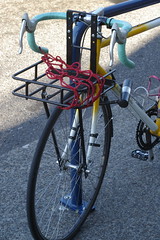
When I came out of the store today and walked over to my bicycle to load it up, I spotted this 1986 Trek 1000 (three years older than mine) with a 5 rail CETMA rack attached to it. These racks are far prettier (and smaller!) in real life than they are on the CETMA website.
The only problems with them appear to be
- The struts are attached to the middle rails instead of the edge rails (I’d be happier if they were triangulated out.)
- These struts DO NOT PLAY WELL with quick-release skewers; it looks like you’d have to completely unscrew and remove the skewer to get the wheel out, and if you’re going to do that you might as well go back to a nutted axle.
- The handlebar hanger stands quite a bit proud of the handlebar. But that might be usable as an elevated bar for a light and/or a GPS unit, so I’m not sure if that’s an actual problem or not.
Too bad the fenced 5-rail unit is US$200 :-(
—orc Thu Sep 10 18:40:12 2009
Discount has been pushed up to version 1.5.3 by the removal of one small defect;
it turned out that I was misreading the spec and I was treating [text]whitespace(text) as a link, when, instead, it should just be text. It’s not much of a defect, but it is still a defect, so here’s some New Code! that is sure to cause sadness and pain to those of you who have gotten used to this aberrant behavior.
—orc Thu Sep 10 10:39:21 2009
Sep 09, 2009
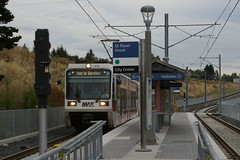
The new line to Clackamas Towne Center is opening this weekend, and Tri-Met is doing last-minute training runs with all of the streetcars they’re planning to use on the line. I spotted this train running south when I was on Flavel St. headed west, so I parked myself at the Flavel St. station until it returned 10 minutes later.
—orc Wed Sep 9 21:07:57 2009
Sep 07, 2009
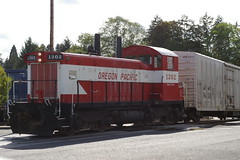
This afternoon, as I headed out for a short loop on the Springwater Trail, the railroad crossing lights on 17th Ave started to go and this short train pulled across 17th and down into the industrial park. I followed it, and reached 19th & Ochoco just as it started backing down into the siding alongside the Goodwill store.
In a “I need to build my midlife-crisis-mobile” moment, both times I saw the train I had to do this routine:
- Stop
- dismount from my bicycle
- open the saddlebag
- extract my purse
- extract my camera
- take the picture
If I had a
bike with a porteur rack, step two and step 4 would not be necessary (a front bag would take the place of my purse altogether) and I might even be able to pull the camera out and take pictures without having to stop the bicycle, though the teeny detail that I’m using manual focus lenses without automatic apertures weighs against it.
—orc Mon Sep 7 22:44:41 2009

As part of my delusion that I’m actually a randonneur, I’ve been keeping track of the various brevets, populaires, and calls for riders on various permanents in this neck of the woods. Unfortunately, none of them have been based out of Portland, and to ride them would involve waking up at 3am, riding a fast two hours to get to the start, riding the loop, and then returning. I am not, by any stretch of the imagination, a morning person (the only thing that got me to ride the three group rides I did this year was that I’d put money down which would go to waste if I didn’t wake up at 5am and drag myself out the door, and even then it’s a pretty hard struggle to get out the door.) So, as a result of this, the only populaires and brevets I’ve run are the ones I made up out of whole cloth.
This is good, but it doesn’t have the same feel as some of the epic (and not so epic) death marches that I read about on various randonneuring weblogs. So when Bill Alsup wrote to the Orrando list asking if people would be interested in running Michael Wolfe’s starting-at-the-Hawthorne-Bridge UGB 200k on 5-Sep, I jumped at the invitation.
The nice thing about the whole “Hawthorne Bridge” part of the brevet was that it’s about 12 minutes from home if I hustle. Which I needed to do, because after I was awakened on Saturday morning by a heavy rainfall, I spent the next 70 minutes looking at the weather forecasts and waffling about whether I should just forget about the whole thing. Finally, at about 6:45, I said “oh, to devil with it”, threw on my clothes (I had prepared the trek the night before and only needed to attach a cue sheet holder [which I ended up forgetting, and ended up carrying the cuesheet in my hand or wedged into my pocket for the entire loop] and GPS) and stepped out the door into the pouring rain.
The official opening for the route was 7:30am, but the four riders didn’t make it away from the start until about 7:35 (at least that’s what my GPS claims), and we leisurely ambled down the Springwater Trail until Sellwood, when the group split in half (Keith [who’s last name I don’t remember] and I were a little faster than Bill Alsup and Ken Mattina) and slowly drifted apart.
The curse of riding along the Springwater Trail is that I’ve done it so many times that I was on autopilot, and since I was riding with someone I moderated my headlong rush and got into the first control (the convenience store at Bell & Johnson Creek blvd) at the very last minute. After getting our cards signed (I’d actually gotten a snack, but the cash register there had a ridiculously fast clock) and wedging mine back into my pocket,
we got back onto our bicycles and headed out into the torrent.
One thing to be said about the Springwater Trail when it’s raining is that the slugs /really/ like it. The next dozen or so miles down to Boring were enlivened by having to dodge approximately 100 million slugs, which distracted me from the tiny detail that it was raining so hard that I was getting soaked to the skin from my face down to my toes (the oracle used tape to weatherproof his helmet, so I’d done the same with mine,) including the pocket that contained my poor brevet card.
When I reached the control in Boring, I pulled out the card and realized my mistake when it started to disintegrate as I tried to peel it open. Oops. I crossed my fingers that I’d be able to pry it apart later and decided that I would use receipts from there on instead of asking someone to sign and date what had become nothing more than a badly shaped piece of paper mache. So I bought a coffee drink, shoved the receipt into my purse, shoved the coffee into my gullet, and headed off down the road towards the Clackamas River valley.
It’s usually quite pretty once you get south of Boring, but it was raining too hard to appreciate it, and the only entertainment here was playing leapfrog on the road as it climbed, descended, climbed, descended, climbed, then plunged down into the Clackamas River valley. We crossed the river at Barton, then started heading up the hill towards Fischers Mill, only to ride by some poor woman sitting sobbing hopelessly at the side of the road.
Well, we certainly weren’t going to abandon someone at the side of the road, so we stopped and tried to figure out what we could do to help. We offered to go for help or call 911, but neither of those suggestions were greeted with any sort of enthusiasm, so we stood around trying to comfort the woman until a car came by and someone there quietly called 911 while we waited. 15 minutes later an EMT truck showed up, followed by a firetruck, and we bolted up the road towards Fischers Mill as the paramedics took over.
The road to Fischers Mill is annoyingly steep, but it’s pretty short, so I put my head down and cranked myself up to the intersection with Springwater Road, and then down (uh, oh) into the valley that contains Fischers Mill. And then up again, winding up the side of a series of bluffs to the top of the ridgeline that sits west of the Clackamas River (a very pretty climb, but the downpour [and, alas, the humanitarian delay] dampened any enthusiasm for sightseeing), then up the ridge (south == towards the mountains == uphill) to Highland road, and then across rolling hills down to Canby.
I had a small mechanical problem on the way down to Canby. I managed to wrap my old chain around the crank last week, and it managed to tweak the front derailer during its death throes. This ended up adjusting the derailer so that an enthusiastic shift from alpine gear (40 teeth) to fast gear (52 teeth) would instead shift into my standing still gear (aka the chain thrown completely off the crank gear and into my pedals. I’d thought I had fixed this, but when I was coming down a steep hill on Spangler Road, I shifted up to get some more speed and ended up coasting, muttering dire curses under my breath, to a stop so I could wrap the chain back onto the gear.
But, despite all of this, we’d still managed to pick up 20 minutes by the time we reached the control in Canby, so we could burn off 20 minutes grabbing a little lunch before heading out into the rain again.
Now, the interesting part about “heading out into the rain again” is that despite being soaked to the skin for the last 50 miles or so I was fairly warm, because all of the woolen clothing I was wearing was doing yeoman duty at pulling the water away from my skin and letting it evaporate into the air. So if I was moving, I’d be working hard enough to build up a layer of warmth between me and the freezing cold evaporating water that soaked my clothing. But when I’d stop, for, oh, 20 minutes or so, all that warmth would go away and there’d be nothing between me and extinction in the cold, and thus when I headed out from Canby I spent the next 45 minutes shivering until my body was able to catch up to the evaporative losses. And it doesn’t really help that the roads west of Canby go through some very flat farmland, where the only thing stopping the relentless north wind and rain were two wet-pet-get bicyclists.
Eventually we reached the Willamette River, where three good things and one bad thing happened. The good things were that
- it stopped raining,
- the sun came out, and
- we dropped down to the bottom of the mini-gorge that holds the Willamette, and got out of the wind.
The bad thing is that when we hit the Champoeg Park bicycle path, Keith’s bicycle went into a pothole, which knocked a bungee cord loose, and the loose cord wrapped itself around the rear wheel and punctured his tire.
Whoops. He stopped, I stopped to assist, he replaced his tire, then realized that his mini-pump wasn’t capable of fully inflating his tire (and my pump wouldn’t work, because my bicycle is a Presta-valve joint while his is Schrader.) I suggested letting him use myspare tire, which could be inflated with my pump, but he was worried that this would leave me without a spare and decided to limp along to the next gas station (Newburg was only about 10 miles off at this point.) Now, I don’t know if I could have made it the first 50 wet miles without having someone else around to leapfrog, so I wasn’t going to drop him there (if I had a flat on a long ride, I’d certainly hate to be dropped,) so I said I’d ride along with him, and we crept in unison the 10 long miles to Newburg, where we found a bicycle shop and got his tire reinflated (and me a pair of fingerless gloves, because the full-finger gloves I was wearing were full of water and converting my fingers into shrivelled raisins.)
I don’t know how much time we lost doing this, but it was a lot, because we didn’t make it into Gaston until 25 minutes before the control closed, and the ride from Newburg to Gaston is basically dead flat and we had a lovely tailwind that pushed us along at an average of 20 mph all the way from Newburg.
This was the prettiest part of the ride. It’s safely outside the UGB, so it’s all farmland with forested hills, the sun was (mainly) out so it was nice and warm, and there was very little traffic as we went screaming northwards. This was the point where rando amnesia set in and the unpleasantness of the early morning faded into a vague and not completely unpleasant memory.
From Gaston north we moved into the unpleasantly sterile suburban development around Hillsboro (including the longest and most tedious part of the trip, which was the 3 or so miles of Evergreen (a generic suburban speedway that could be picked up and transplanted into Chicago, Los Angeles, or San Francisco without being at all out of place) that looped around the north side of Hillsboro airport), and north into the threatened farmlands around Helvetia and across to the final transit control of the ride at the Rock Creek Tavern, where we parked ourselves and took full advantage of the ~70 minutes of time we had picked up.
Once you leave the Rock Creek Tavern things become a little more exciting, because the Tualatin Mountains sit between there and downtown Portland. So we sailed out of the parking lot, turned towards the mountain, and instantly encountered the 270(ish) meter climb up to the top of Skyline Blvd. This is a pretty climb, too, but by now the sun was plummeting towards the banks of clouds massing on the horizon, so once again the bulk of my energy was devoted to pushing the xtracycle up the hill as fast (fsvo “fast”; I outclimbed Keith, but various roadies kept blowing past me as if I was standing still) as my legs could push it. And then I reached the summit, cautiously shifted back to my 52 tooth ring, stopped, turned on all of my lights, put on my shockingly yellow “please don’t kill me” rain jacket, then quickly dropped down Thompson Road to the city, stopping only to look at the cue sheet to figure out the twisty directions that lead from Cornell Road down to Raleigh.
When I reached Naito Parkway, it was only about 19:40, so I took a more leisurely rate down towards the Hawthorne bridge. There was a false trigger of the railroad crossing gates at the Steel bridge which stopped me for a couple of minutes until the gates went up again, and then I slowly navigated along the path past the new Saturday Market, the steamship Portland, and to the Hawthorne bridge, picking up Keith in the last mile (I’d pulled a long ways ahead climbing the hill, but the stops for cue sheet reading and trainspotting slowed my descent) and pulling up to the end of the route at almost exactly 8pm (and then it took a couple of minutes to get a Dr. Pepper, so my final receipt shows that I made it in 12h32 after the official starting time (12h27 from when I rolled out of the parking lot and pushed the “record” button on my GPS.)
This was an extraordinarily nice outing, on an extraordinarily nice route. I need to do more permanents and brevets now, if only I can figure a good way of dealing with the suburban orientation of most of the established loops. Travelling in a small group helped restrain some of my “go all out until I run out of steam, then stagger back home” tendencies that came out when I converted the Portland Century into a 200k loop, and I was still full of energy when I got home afterwards (this didn’t last too long; when I started to relax, I suddenly got very tired and collapsed in a heap.)
Using an Xtracycle for brevets is still a fairly silly thing to do, but I will note that it’s really nice to have basically unlimited cargo capacity in a vehicle that rides like an ordinary bicycle. I was able to carry an entire change of clothes (with two extra pairs of socks), a bag of “energy” bars (cookie bars, really, and little sugary gelatin blocks) which I barely touched, all of the leftover food that I purchased at controls (being able to tuck a bottle of sodapop and a bottle of sugary coffee drink away for later may not have been a lifesaver, but it made a very nice midflight snack), my purse (with my Pentax, the poor battered brevet card and my receipts, and some more cookie bars which I had overlooked from earlier,) plus my lock, a couple of grocery bags, and a spare jersey that I’d left on the bicycle from the loop I did on friday, and it didn’t weigh me down enough to force me to walk either of the hills. I’m still planning on building a midlife crisis-mobile for any hypothetical death marches out there, but I might be able to push 400 km out of the Xtracycle if I am able to build up my strength on it.
But I’ve got an offically approved R200 under my belt, a RUSA membership I can apply it to now, and a bicycle that can go the distance without much fuss, muss, or bother. I am a happy man.
—orc Mon Sep 7 00:50:40 2009
Sep 05, 2009
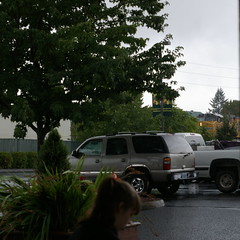
A Yellow Menace freight zips by behind a row of bushes at the Canby Thriftway (what was I doing there? I was riding a permanent and the Thriftway was one of the controls. Why is the train such a tiny part of the picture? Because it was raining, and since I had just ridden 50 miles in the pouring rain there was no way I was going to go scampering out into it just to get a picture.)
—orc Sat Sep 5 22:41:57 2009
Sep 04, 2009

When I was coming back from this afternoon’s (short) loop, I spotted EPT 501 just as I went under the Larrabee Ave offramp (from Interstate Ave; it’s funny how my bike rides tend to involve trains), so I had to stop and get a better picture than the last one I took.
—orc Fri Sep 4 22:17:46 2009

When a Dust Mite goes on holiday, it’s often to secluded hideaways under the sofa or loveseat. And they never send postcards.
—orc Fri Sep 4 21:55:14 2009
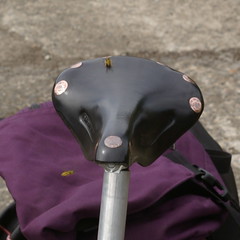
A couple of yellowjackets admire the (finally starting to break in after 9 months and 9,500km) Brooks saddle on my Trek.
—orc Fri Sep 4 19:02:23 2009
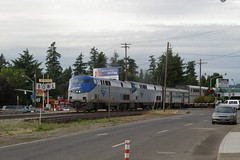
I rode down to Milwaukie this afternoon to deliver something to my parents, and when I was coming back I realized that I’d reach the SPYellow Menace mainline at around the time the southbound Coast Starlight came through. So I parked my bicycle close to the tracks, pulled out the Pentax, and waited (and waited and waited and waited…) for something to show up.
It took half an hour, but the train finally came zipping through.
—orc Fri Sep 4 18:57:55 2009
Sep 02, 2009
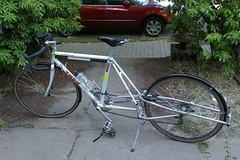
I’m planning on doing a R200 this weekend, and, since the weather forecast calls for rain, I’ve installed a new pair of fenders on the bicycle. These fenders are fairly narrow (35mm) and my tires are fairly wide (27mm), so even after carefully installing them (my Trek 1000 is not as hilariously badly proportioned as modern carbon fiber bicycles, but it’s still not built for wide tires and fenders, so the front fender has this large hole carved into it to fit the front brake into; you’d think the Free Radical would have better dimensions, but, no, it comes from a mountain biking background and even though the rear wheel well is wide enough to fit a 28mm tire, it’s not long enough to fit that tire and a fender that comes down to the fender mount at the front of the well. So the rear fender is zip-tied to the upper member of the bridge, right under the Mavic cantilever brake post adjuster that I’ve reworked into a sidepull brake mount) I wanted to take the bicycle out for a short loop to satisfy myself that the fenders wouldn’t immediately fall apart and hurl themselves into my wheels at speed.
So I took the saddlebags and their mounting rails off and went out for a short urban loop of about 10 miles. Oddly enough, when you take 20 pounds off the bicycle (the Trek as pictured weighs just under 30 pounds, as compared to 50 pounds for the fully loaded with saddlebags, lock, toolkit, and purse with camera) the thing becomes noticeably faster; I averaged 16.6mph looping out to 82nd and back, and this was with a fairly unpleasant crosswind for most of the trip; my previous high speed loop was 16.3mph, and that was encouraged by being a little late to a lunch meeting downtown and then having a nice tailwind on the way back. It makes the lure of the <<20pound bicycle seem much more understandable.
Maybe if I win the lottery I’ll hire a framebuilder to make me a nice light titanium xtracycle, then go berserk shopping for ultra-light components to build it up with.
—orc Wed Sep 2 22:27:02 2009
—30—





























